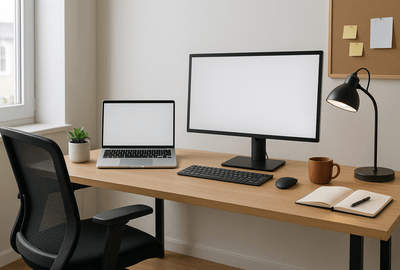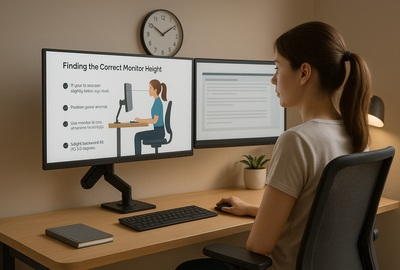- How to Stay Focused at Work: Proven Strategies to Improve Focus and Productivity
- 1. Improve Focus with a Daily Routine to Boost Attention Span
- 2. Eliminate Distractions and Prioritize Tasks for Better Focus at Work
- 3. Create a Quiet Environment to Support Deep Work and Concentration
- 4. Use the Pomodoro Technique and Structured Breaks to Sustain Focus
- 5. Improve Concentration with Physical Activity and Mental Hygiene
- 6. Stay Focused at Work by Avoiding Constant Distractions and Task Switching
- 7. Prevent Burnout and Protect Energy to Maintain Focus
- 8. Build Lasting Focus by Minimizing Digital Distractions and Practicing Smart Habits
- Final Word: You Don’t Need More Hours. You Need More Focus.
How to Stay Focused at Work: Proven Strategies to Improve Focus and Productivity
If you're constantly distracted or struggling to finish what you start, you're not alone. In a world full of noise—both literal and digital—learning how to stay focused at work is one of the most valuable professional skills you can develop. This isn’t about working harder. It’s about creating the right environment, habits, and mindset to help you do more with less stress.
These strategies are built on real workplace experience and rooted in practical, sustainable habits that help you improve focus, get through your daily tasks, and feel good doing it.
1. Improve Focus with a Daily Routine to Boost Attention Span
A smart daily routine is more than just waking up early. It's a system that protects your energy, time, and attention span—three things essential for staying productive throughout the entire day.
Start by identifying your peak performance window. For many people, this is mid-morning. Block out that time for deep work—the complex, creative thinking tasks that require your full concentration. Avoid scheduling meetings or answering emails during this window. Save those for later, less focused parts of the day.
Before diving in, take five minutes to review your to do list and clarify your top priorities. A long, lengthy to do list can feel like a mountain. Instead, highlight your most important task and break the rest into specific blocks of time. This not only organizes your brain—it helps with maintaining focus.
A copywriter I know sets their timer at 8:30 a.m. each morning and doesn’t check email until 10. That 90-minute focus block alone doubled their writing output in a month. The trick isn’t in the task—it’s in creating the space for it to happen, in such a way that supports long-term performance.
2. Eliminate Distractions and Prioritize Tasks for Better Focus at Work
Modern work environments are flooded with digital distractions—from Slack pings to app updates. Every time you stop to check a message, you burn mental energy. The cost? Lost concentration, slower output, and unfinished tasks.
Conduct a distraction audit: identify your top three distractions. These might be background noise, unplanned phone calls, or scattered notes across multiple apps. These constant distractions break your rhythm before you even get started.
- Set phone to Do Not Disturb
- Block sites during focus time
- Use tools like Focus@Will for soft background music
- Keep a sticky note for mid-flow ideas
Then focus on prioritizing tasks. Select one or two critical tasks that move your goals forward. Use your highest focus hours for these—not for clearing your inbox.
This level of clarity helps you boost productivity and ensures your mental sharpness is spent where it matters most.
3. Create a Quiet Environment to Support Deep Work and Concentration
Your brain needs a quiet environment to perform. If your workspace is chaotic, it’s fighting your focus. Creating a calm setup isn’t just about preference—it’s one of the most effective strategies for consistent performance.
- Use noise canceling headphones to block background noise
- Declutter your desk—this alone can reduce common distractions
- Position yourself in a quiet space with minimal interruptions
Even subtle adjustments like light intensity and airflow improve comfort and well being. A simple desk mat or a view of the outdoors helps too.
One editor turned their cluttered spare room into a minimalist workspace with ambient light and a wall planner. Just one week in, they noted fewer headaches, better ability to concentrate, and less fatigue from switching tasks all day.
4. Use the Pomodoro Technique and Structured Breaks to Sustain Focus
You don’t need to grind through eight hours to feel accomplished. Instead, use the Pomodoro technique—a favorite among high performers for a reason.
- Focus for 25 minutes
- Take a 5-minute short break
- After four cycles, take a 30-minute reset
During breaks, engage in light movement, eat something nourishing, or just breathe. Even brief breaks—less than five minutes—can restore clarity and give your brain a chance to reset without derailing focus. Taking regular breaks helps you keep your energy up without sacrificing productivity.
A UX team I advised adopted Pomodoro blocks across time zones. The result? Fewer miscommunications and a 20% drop in late-stage revisions.
5. Improve Concentration with Physical Activity and Mental Hygiene
When your body feels good, your brain performs better. That’s not opinion—it’s proven. Simple physical activity boosts blood flow, energy, and cognitive function.
- Take stairs instead of elevators
- Do desk stretches every hour
- Walk during phone meetings
This isn’t just about fitness. It’s about staying mentally agile, improving your overall well being, and building sustainable performance.
Nutrition also plays a role. Avoid sugar crashes and opt for hydration and brain-friendly snacks like almonds or berries. These help reduce stress and increase mental energy during long afternoons.
6. Stay Focused at Work by Avoiding Constant Distractions and Task Switching
Multitasking feels productive, but it breaks flow. Instead, commit to one task at a time and guard it.
- Block time for specific tasks
- Use a timer to manage time limits
- Transition between different tasks with breathwork or journaling
Each time you avoid the urge to context switch, you strengthen your attention span and concentration. You’ll find it easier to concentrate longer and with better output.
7. Prevent Burnout and Protect Energy to Maintain Focus
No focus system works without energy. Learn to manage it, and you unlock your full ability.
- Prioritize sleep and downtime
- Track your energy levels
- Use systems to manage your tasks
Recovery is essential. Schedule regular breaks. Protecting your personal life isn’t selfish—it’s a performance strategy. Consider taking regular breaks as part of your core productivity strategies.
8. Build Lasting Focus by Minimizing Digital Distractions and Practicing Smart Habits
Real focus comes from repetition, not inspiration. Build routines that reinforce your best habits.
- Log distractions
- Adjust your patterns
- Try different techniques monthly
Researchers found that shared goals and feedback loops increase team productivity. Build your systems in such a way that they support both performance and recovery. Fall back on the right strategies—the ones you’ve tested and trust.
Final Word: You Don’t Need More Hours. You Need More Focus.
Build systems that support your goals, and you’ll enjoy more output, more clarity, and more control. Begin with one change—whether it’s the Pomodoro technique or simply adjusting your workspace—and build from there.
Because when you stay focused with the right mindset, you’ll not only achieve more—you’ll enjoy the work as you go.


 Buy Now, Pay Later
Buy Now, Pay Later Verified Rating
Verified Rating 




